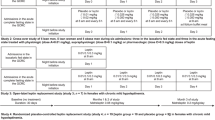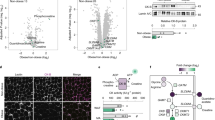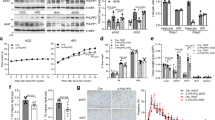Abstract
Background/Objective:
Adiponectin exerts beneficial effects by reducing inflammation and improving lipid metabolism and insulin sensitivity. Although the adiponectin level is lower in obese individuals, whether weight gain reduces adiponectin expression in humans is controversial. We sought to investigate the role of weight gain, and consequent changes in leptin, on altering adiponectin expression in humans.
Methods/Results:
Forty-four normal-weight healthy subjects were recruited (mean age 29 years; 14 women) and randomized to either gain 5% of body weight by 8 weeks of overfeeding (n=34) or maintain weight (n=10). Modest weight gain of 3.8±1.2 kg resulted in increased adiponectin level (P=0.03), whereas weight maintenance resulted in no changes in adiponectin. Further, changes in adiponectin correlated positively with changes in leptin (P=0.0085). In-vitro experiments using differentiated human white preadipocytes showed that leptin increased adiponectin mRNA and protein expression, whereas a leptin antagonist had opposite effects. To understand the role of leptin in established obesity, we compared adipose tissue samples obtained from normal-weight versus obese subjects. We noted, first, that leptin activated cellular signaling pathways and increased adiponectin mRNA in the adipose tissue from normal-weight participants, but did not do so in the adipose tissue from obese participants. Second, we noted that obese subjects had increased caveolin-1 expression, which attenuates leptin-dependent increases in adiponectin.
Conclusions:
Modest weight gain in healthy individuals is associated with increases in adiponectin levels, which correlate positively with changes in leptin. In vitro, leptin induces adiponectin expression, which is attenuated by increased caveolin-1 expression. In addition, the adipose tissue from obese subjects shows increased caveolin-1 expression and impaired leptin signaling. This leptin signal impairment may prevent concordant increases in adiponectin levels in obese subjects despite their high levels of leptin. Therefore, impaired leptin signaling may contribute to low adiponectin expression in obesity and may provide a target for increasing adiponectin expression, hence improving insulin sensitivity and cardio-metabolic profile in obesity.
This is a preview of subscription content, access via your institution
Access options
Subscribe to this journal
Receive 12 print issues and online access
$259.00 per year
only $21.58 per issue
Buy this article
- Purchase on Springer Link
- Instant access to full article PDF
Prices may be subject to local taxes which are calculated during checkout





Similar content being viewed by others
References
Scherer PE, Williams S, Fogliano M, Baldini G, Lodish HF . A novel serum protein similar to C1q, produced exclusively in adipocytes. J Biol Chem 1995; 270: 26746–26749.
Fruhbeck G . The Sir David Cuthbertson Medal Lecture. Hunting for new pieces to the complex puzzle of obesity. Proc Nutr Soc 2006; 65: 329–347.
Kadowaki T, Yamauchi T, Kubota N, Hara K, Ueki K, Tobe K . Adiponectin and adiponectin receptors in insulin resistance, diabetes, and the metabolic syndrome. J Clin Invest 2006; 116: 1784–1792.
Hu E, Liang P, Spiegelman BM . AdipoQ is a novel adipose-specific gene dysregulated in obesity. J Biol Chem 1996; 271: 10697–10703.
Arita Y, Kihara S, Ouchi N, Takahashi M, Maeda K, Miyagawa J et al. Paradoxical decrease of an adipose-specific protein, adiponectin, in obesity. Biochem Biophys Res Commun 1999; 257: 79–83.
Cnop M, Havel PJ, Utzschneider KM, Carr DB, Sinha MK, Boyko EJ et al. Relationship of adiponectin to body fat distribution, insulin sensitivity and plasma lipoproteins: evidence for independent roles of age and sex. Diabetologia 2003; 46: 459–469.
Heilbronn LK, Campbell LV, Xu A, Samocha-Bonet D . Metabolically protective cytokines adiponectin and fibroblast growth factor-21 are increased by acute overfeeding in healthy humans. PLoS One 2013; 8: e78864.
Brons C, Jensen CB, Storgaard H, Hiscock NJ, White A, Appel JS et al. Impact of short-term high-fat feeding on glucose and insulin metabolism in young healthy men. J Physiol 2009; 587: 2387–2397.
Ukkola O, Teran-Garcia M, Tremblay A, Despres JP, Bouchard C . Adiponectin concentration and insulin indicators following overfeeding in identical twins. J Endocrinol Invest 2008; 31: 132–137.
Astrand O, Carlsson M, Nilsson I, Lindstrom T, Borga M, Nystrom FH . Weight gain by hyperalimentation elevates C-reactive protein levels but does not affect circulating levels of adiponectin or resistin in healthy subjects. Eur J Endocrinol 2010; 163: 879–885.
Cahill F, Amini P, Wadden D, Khalili S, Randell E, Vasdev S et al. Short-term overfeeding increases circulating adiponectin independent of obesity status. PLoS One 2013; 8: e74215.
Aguilar-Salinas CA, Garcia EG, Robles L, Riano D, Ruiz-Gomez DG, Garcia-Ulloa AC et al. High adiponectin concentrations are associated with the metabolically healthy obese phenotype. J Clin Endocrinol Metab 2008; 93: 4075–4079.
Shetty S, Kusminski CM, Scherer PE . Adiponectin in health and disease: evaluation of adiponectin-targeted drug development strategies. Trends Pharmacol Sci 2009; 30: 234–239.
Makimura H, Mizuno TM, Bergen H, Mobbs CV . Adiponectin is stimulated by adrenalectomy in ob/ob mice and is highly correlated with resistin mRNA. Am J Physiol 2002; 283: E1266–E1271.
Zhang W, Della-Fera MA, Hartzell DL, Hausman D, Baile CA . Adipose tissue gene expression profiles in ob/ob mice treated with leptin. Life Sci 2008; 83: 35–42.
Delporte ML, El Mkadem SA, Quisquater M, Brichard SM . Leptin treatment markedly increased plasma adiponectin but barely decreased plasma resistin of ob/ob mice. Am J Physiol 2004; 287: E446–E453.
Huan JN, Li J, Han Y, Chen K, Wu N, Zhao AZ . Adipocyte-selective reduction of the leptin receptors induced by antisense RNA leads to increased adiposity, dyslipidemia, and insulin resistance. J Biol Chem 2003; 278: 45638–45650.
Haque WA, Shimomura I, Matsuzawa Y, Garg A . Serum adiponectin and leptin levels in patients with lipodystrophies. J Clin Endocrinol Metab 2002; 87: 2395.
Licinio J, Caglayan S, Ozata M, Yildiz BO, de Miranda PB, O'Kirwan F et al. Phenotypic effects of leptin replacement on morbid obesity, diabetes mellitus, hypogonadism, and behavior in leptin-deficient adults. Proc Natl Acad Sci USA 2004; 101: 4531–4536.
Ryan AS, Berman DM, Nicklas BJ, Sinha M, Gingerich RL, Meneilly GS et al. Plasma adiponectin and leptin levels, body composition, and glucose utilization in adult women with wide ranges of age and obesity. Diabetes Care 2003; 26: 2383–2388.
Matsubara M, Maruoka S, Katayose S . Inverse relationship between plasma adiponectin and leptin concentrations in normal-weight and obese women. Eur J Endocrinol 2002; 147: 173–180.
Singh P, Peterson TE, Sert-Kuniyoshi FH, Glenn JA, Davison DE, Romero-Corral A et al. Leptin signaling in adipose tissue: role in lipid accumulation and weight gain. Circ Res 2012; 111: 599–603.
Romero-Corral A, Sert-Kuniyoshi FH, Sierra-Johnson J, Orban M, Gami A, Davison D et al. Modest visceral fat gain causes endothelial dysfunction in healthy humans. J Am Coll Cardiol 2010; 56: 662–666.
Adachi T, Sert-Kuniyoshi FH, Calvin AD, Singh P, Romero-Corral A, van der Walt C et al. Effect of weight gain on cardiac autonomic control during wakefulness and sleep. Hypertension 2011; 57: 723–730.
Singh P, Somers VK, Romero-Corral A, Sert-Kuniyoshi FH, Pusalavidyasagar S, Davison DE et al. Effects of weight gain and weight loss on regional fat distribution. Am J Clin Nutr 2012; 96: 229–233.
Zhang J, Matheny MK, Tumer N, Mitchell MK, Scarpace PJ . Leptin antagonist reveals that the normalization of caloric intake and the thermic effect of food after high-fat feeding are leptin dependent. Am J Physiol Regul Integr Comp Physiol 2007; 292: R868–R874.
Tumer N, Erdos B, Matheny M, Cudykier I, Scarpace PJ . Leptin antagonist reverses hypertension caused by leptin overexpression, but fails to normalize obesity-related hypertension. J Hypertens 2007; 25: 2471–2478.
Shpilman M, Niv-Spector L, Katz M, Varol C, Solomon G, Ayalon-Soffer M et al. Development and characterization of high affinity leptins and leptin antagonists. J Biol Chem 2011; 286: 4429–4442.
McGillicuddy FC, Chiquoine EH, Hinkle CC, Kim RJ, Shah R, Roche HM et al. Interferon gamma attenuates insulin signaling, lipid storage, and differentiation in human adipocytes via activation of the JAK/STAT pathway. J Biol Chem 2009; 284: 31936–31944.
Simons PJ, van den Pangaart PS, Aerts JM, Boon L . Pro-inflammatory delipidizing cytokines reduce adiponectin secretion from human adipocytes without affecting adiponectin oligomerization. J Endocrinol 2007; 192: 289–299.
Hajri T, Tao H, Wattacheril J, Marks-Shulman P, Abumrad NN . Regulation of adiponectin production by insulin: interactions with tumor necrosis factor-alpha and interleukin-6. Am J Physiol Endocrinol Metab 2011; 300: E350–E360.
Tam CS, Covington JD, Bajpeyi S, Tchoukalova Y, Burk D, Johannsen DL et al. Weight gain reveals dramatic increases in skeletal muscle extracellular matrix remodeling. J Clin Endocrinol Metab 2014; 99: 1749–1757.
Alligier M, Meugnier E, Debard C, Lambert-Porcheron S, Chanseaume E, Sothier M et al. Subcutaneous adipose tissue remodeling during the initial phase of weight gain induced by overfeeding in humans. J Clin Endocrinol Metab 2012; 97: E183–E192.
Tam CS, Viardot A, Clement K, Tordjman J, Tonks K, Greenfield JR et al. Short-term overfeeding may induce peripheral insulin resistance without altering subcutaneous adipose tissue macrophages in humans. Diabetes 2010; 59: 2164–2170.
Liu M, Liu F . Transcriptional and post-translational regulation of adiponectin. Biochem J 2010; 425: 41–52.
Khan T, Hamilton MP, Mundy DI, Chua SC, Scherer PE . Impact of simvastatin on adipose tissue: pleiotropic effects in vivo. Endocrinology 2009; 150: 5262–5272.
Razani B, Combs TP, Wang XB, Frank PG, Park DS, Russell RG et al. Caveolin-1-deficient mice are lean, resistant to diet-induced obesity, and show hypertriglyceridemia with adipocyte abnormalities. J Biol Chem 2002; 277: 8635–8647.
Asterholm IW, Mundy DI, Weng J, Anderson RG, Scherer PE . Altered mitochondrial function and metabolic inflexibility associated with loss of caveolin-1. Cell Metab 2012; 15: 171–185.
Kuroki M, O'Flaherty JT . Extracellular signal-regulated protein kinase (ERK)-dependent and ERK-independent pathways target STAT3 on serine-727 in human neutrophils stimulated by chemotactic factors and cytokines. Biochem J 1999; 341: 691–696.
Chung J, Uchida E, Grammer TC, Blenis J . STAT3 serine phosphorylation by ERK-dependent and -independent pathways negatively modulates its tyrosine phosphorylation. Mol Cell Biol 1997; 17: 6508–6516.
Gough DJ, Koetz L, Levy DE . The MEK-ERK pathway is necessary for serine phosphorylation of mitochondrial STAT3 and Ras-mediated transformation. PLoS One 2013; 8: e83395.
O'Rourke L, Shepherd PR . Biphasic regulation of extracellular-signal-regulated protein kinase by leptin in macrophages: role in regulating STAT3 Ser727 phosphorylation and DNA binding. Biochem J 2002; 364: 875–879.
Zhou Z, Neupane M, Zhou HR, Wu D, Chang CC, Moustaid-Moussa N et al. Leptin differentially regulate STAT3 activation in ob/ob mouse adipose mesenchymal stem cells. Nutr Metab (Lond) 2012; 9: 109.
Bravard A, Vial G, Chauvin MA, Rouille Y, Bailleul B, Vidal H et al. FTO contributes to hepatic metabolism regulation through regulation of leptin action and STAT3 signalling in liver. Cell Commun Signal 2014; 12: 4.
Zhang Y, Wu X, He Y, Kastin AJ, Hsuchou H, Rosenblum CI et al. Melanocortin potentiates leptin-induced STAT3 signaling via MAPK pathway. J Neurochem 2009; 110: 390–399.
Mark AL . Selective leptin resistance revisited. Am J Physiol Regul Integr Comp Physiol 2013; 305: R566–R581.
Konner AC, Bruning JC . Selective insulin and leptin resistance in metabolic disorders. Cell Metab 2012; 16: 144–152.
Martin SS, Qasim A, Reilly MP . Leptin resistance: a possible interface of inflammation and metabolism in obesity-related cardiovascular disease. J Am Coll Cardiol 2008; 52: 1201–1210.
Labruna G, Pasanisi F, Nardelli C, Caso R, Vitale DF, Contaldo F et al. High leptin/adiponectin ratio and serum triglycerides are associated with an "at-risk" phenotype in young severely obese patients. Obesity 2011; 19: 1492–1496.
Finucane FM, Luan J, Wareham NJ, Sharp SJ, O’Rahilly S, Balkau B et al. Correlation of the leptin:adiponectin ratio with measures of insulin resistance in non-diabetic individuals. Diabetologia 2009; 52: 2345–2349.
Inoue M, Yano M, Yamakado M, Maehata E, Suzuki S . Relationship between the adiponectin-leptin ratio and parameters of insulin resistance in subjects without hyperglycemia. Metabolism 2006; 55: 1248–1254.
Niswender KD, Schwartz MW . Insulin and leptin revisited: adiposity signals with overlapping physiological and intracellular signaling capabilities. Front Neuroendocrinol 2003; 24: 1–10.
Kahn BB, Flier JS . Obesity and insulin resistance. J Clin Invest 2000; 106: 473–481.
Mantzoros CS, Magkos F, Brinkoetter M, Sienkiewicz E, Dardeno TA, Kim SY et al. Leptin in human physiology and pathophysiology. American journal of physiology. Endocrinol Metab 2011; 301: E567–E584.
Acknowledgements
This work was supported by American Heart Association Scientist Development Grant 11SDG7260046 (to PS), a grant from the European Regional Development Fund–Project FNUSA-ICRC (number CZ.1.05/1.1.00/02.0123 to PS, FLJ, TK and VKS), NIH grant (DK81014, HL73211 and HL65176 to VKS), and DK45343 to MDJ), the National Center for Research Resources (grant 1UL1 TR000135), which is a component of the NIH, and the NIH Roadmap for Medical Research.
Author information
Authors and Affiliations
Corresponding author
Ethics declarations
Competing interests
The authors declare no conflict of interest.
Additional information
Supplementary Information accompanies this paper on International Journal of Obesity website
Supplementary information
Rights and permissions
About this article
Cite this article
Singh, P., Sharma, P., Sahakyan, K. et al. Differential effects of leptin on adiponectin expression with weight gain versus obesity. Int J Obes 40, 266–274 (2016). https://doi.org/10.1038/ijo.2015.181
Received:
Revised:
Accepted:
Published:
Issue Date:
DOI: https://doi.org/10.1038/ijo.2015.181
This article is cited by
-
Periconceptional biomarkers for maternal obesity: a systematic review
Reviews in Endocrine and Metabolic Disorders (2023)
-
Resveratrol and Dulaglutide ameliorate adiposity and liver dysfunction in rats with diet-induced metabolic syndrome: Role of SIRT-1 / adipokines / PPARγ and IGF-1
DARU Journal of Pharmaceutical Sciences (2023)
-
Metabolic syndrome and esophageal cancer risk: a systematic review and meta‑analysis
Diabetology & Metabolic Syndrome (2021)
-
Associations of leptin and adiponectin with incident type 2 diabetes and interactions among African Americans: the Jackson heart study
BMC Endocrine Disorders (2020)
-
The leptin to adiponectin ratio (LAR) is reduced by sleeve gastrectomy in adults with severe obesity: a prospective cohort study
Scientific Reports (2020)



